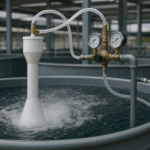When is UV Alone NOT Enough?
High-Density RAS → Combine UV with ozone or protein skimmer.
Marine Systems → UV + ozone for better organics control.
Why Ozone is a Game-Changer for RAS
1. Unbeatable Pathogen Destruction
Kills 99.9% of bacteria, viruses, parasites, and fungi (even resistant ones like Vibrio and Ich).
Superior to UV (which only treats water passing through it).
2. Breaks Down Organic Waste
Oxidizes dissolved organics (proteins, fish mucus, tannins) that UV and mechanical filters can’t remove.
Reduces biofilm in pipes and tanks.
3. Improves Water Clarity & Oxygen Levels
Removes yellowing compounds (humic acids) for crystal-clear water.
No foam or odors (unlike protein skimmers alone).
4. Reduces Biofilter Load
By breaking down organics before they decompose into ammonia, ozone extends biofilter life.
5. No Toxic Residues (If Used Properly)
Decomposes into oxygen (O₂) after use (unlike chlorine, which leaves harmful chloramines).
How to Use Ozone Safely in RAS
Ozone is powerful but dangerous if misapplied. Follow these critical rules:
1. Proper Ozone Dosing
Recommended ORP (Oxidation-Reduction Potential): 250–350 mV → Safe for most fish.
400+ mV → Risk of gill damage.
Residual O₃ must be ≤ 0.01 ppm in fish tanks (use activated carbon or UV destruct unit).
2. Must Be Paired with Filtration
✔ Pre-filtration (drum filter, protein skimmer) removes solids first.
✔ Post-treatment (carbon filter or degassing chamber) removes excess ozone.
3. Never Inject Ozone Directly into Fish Tanks
Always treat water in a separate contact chamber before returning it to the system.
4. Monitor with ORP & Ozone Sensors
Automated controllers shut off ozone if levels exceed safety limits.

